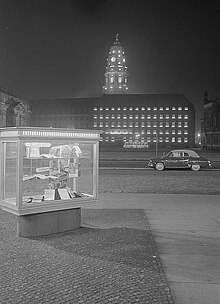Reformed Church (Dresden)
The Reformed Church was the second church building of the Evangelical Reformed congregation in Dresden . It was located on Friedrichsring (formerly Ringstrasse 17 b) in the old town . The church, built in neo-Romanesque style from 1892–1894 according to plans by Harald Julius von Bosse , burned down during the air raids on Dresden in 1945. In the post-war period it was first used as a provisional emergency church , then as a cabaret venue and dismantled in the sixties.
history
An Evangelical Reformed community of Huguenot religious refugees existed in Dresden as early as the 17th century. The French community became German-French in the middle of the 18th century and German in the first half of the 19th century.
On August 16, 1764, the community received permission to build a “house of prayer for private religious practice” in Kreuzgasse. The first church building , designed by Samuel Locke , was used for services from 1767. In the course of the planning for the construction of a new town hall , the church should be demolished. In return, the community received a plot of land nearby on the former fortifications on today's Dr.-Külz-Ring .
The new church was planned and built by the architect Harald Julius von Bosse , who was a member of the parish. The foundation stone was laid on June 14, 1892, the opening service took place on March 7, 1894 - three days before the builder's death. Then the old church was demolished.
The sacred building burned out during the air raids on Dresden on February 13, 1945. It was given a makeshift roof in 1947/1948 and could be used again in 1948 as an emergency church for the Christmas service. Continuous use began in February 1949. As early as 1947, the new city planning director Hans Wermund published a list for the report on the publication of the cultural destruction in all of Germany ; In the list of architectural monuments contained therein, the ruins of the Reformed Church were classified as destroyed despite their good state of preservation. One possible reason for this was that the reconstruction of the Reformed Church “was considered hopeless”.

As a result of the air raids, the Hofgärtnerhaus at the end of the Brühl Terrace also burned out. Its reconstruction took place under the direction of the community member Heinrich Rettig . The community moved to this building in 1956.
The church ruin, which had been vacant since 1956, was assigned to the cabaret group Die Herkuleskeule as a venue in 1961 , where it performed in the same year. When the ruin was proposed for demolition, Mayor Gerhard Schill had the city's proposals for demolition confirmed by the office of the SED district leadership in August 1962 . Costs of 90,000 marks were estimated for the demolition, which took place in 1963. The Herkuleskeule moved into the house at Sternplatz 1 in 1965, and the redevelopment of the property on Dr.-Külz-Ring began in 2008.
description
The sacred building was a brick building built on a rectangular floor plan and had a gable roof as the top . There was a roof turret with a belfry on the west facade. The façade of the church rose on a high basement, with a pilaster structure. The portals as well as the windows and the frieze showed round arches.
Organs
First organ (1772-1894)
The Reformed Church received an organ in 1772 from the Silbermann students David Schubert (1688–1757) and Adam Gottfried Oehme (1718–1789). After the demolition of the Old Reformed Church in 1894, its organ was sold to Mahlis and is preserved in the church there.
Sauer organ (1894–1945)
The organ, built in the high romantic style, came from Sauer in Frankfurt (Oder) in 1894 . It had 34 registers , divided into two manuals and the pedal. Out of dissatisfaction with the sound, there were negotiations with Gebr. Jehmlich (Dresden) about a conversion in 1913 , the start of the war in the following year prevented implementation. Plans for a replacement in 1939 were not implemented. The organ was destroyed in the bombing of Dresden.
The disposition of the Sauer organ was as follows:
|
|
|
||||||||||||||||||||||||||||||||||||||||||||||||||||||||||||||||||||||||||||||
Remarks
Jehmlich organ (1949)
After a lot of personal work and the recovery of copper and zinc from the rubble, the community was able to use a new Jehmlich organ from November 1949 - the first new organ in Dresden since the end of the war. This instrument, called the Bach organ, was loaned to the Kreuzkirche from 1957 to 1964 in exchange for a smaller organ .
literature
- Volker Helas : Architecture in Dresden 1800–1900 . Verlag der Kunst Dresden GmbH, Dresden 1991, ISBN 3-364-00261-4 .
- Matthias Lerm : Farewell to old Dresden - Loss of historical building fabric after 1945 . Forum Verlag, Leipzig 1993, ISBN 3-86151-047-2 .
- Manfred Dreßler: The Evangelical Reformed Church . In: City of Dresden (Hrsg.): Lost churches: Dresden's destroyed churches. Documentation since 1938 . Dresden 2018, p. 48–51 ( online edition. PDF; 6.4 MB).
Web links
Individual evidence
- ↑ Evangelical Reformed community in Dresden: history of the community until 1999 . Deviating from this, March 10, 1894 by Manfred Dreßler: Die Evangelisch-Reformierte Kirche , p. 49
- ↑ a b Lerm, p. 42, footnote 19, p. 235
- ↑ Manfred Dreßler: The Evangelical Reformed Church , p. 51
- ↑ Lerm, pp. 188, 235
- ↑ Helas, p. 188 (Reformed Church. Dr.-Külz-Ring (Friedrichsallee). 1892 by von Bosse)
- ^ Organ database , accessed on September 18, 2017
Coordinates: 51 ° 2 ′ 52 ″ N , 13 ° 44 ′ 18 ″ E



